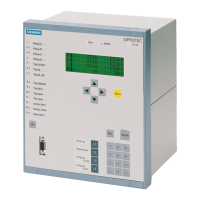2.5 Distance Protection
131
7SD5 Manual
C53000-G1176-C169-1
= PHASE-PHASEONLY the leading phase-phase loop is measured in the event of a
single-phase pick-up in the earthed network. This parameter can only be altered with
DIGSI
®
under Additional Settings.
The meaning of the settings is illustrated in Figure 2-40. Iph> (section a, address
1911) is the minimum current as described in the previous section, Iph>> (section c)
is the overcurrent pickup.
Figure 2-40 Parameters of the U/I/ϕ pickup
Angular dependence is not needed in the majority of cases. Then the voltage-depen-
dent section b is valid which results in the characteristic a-b-c. When controlling with
Uphe
the voltages for phase-to-earth current are inserted in address 1912 Uph-e
(I>>) and 1913 Uph-e (I>) for the voltage-dependent section b. When controlling
with Uphph
the voltages for phase-to-phase are set in address 1914 Uph-ph (I>>)
and 1915 Uph-ph (I>). The relevant settings are determined according to the
pickup mode (see above).
The characteristic has to be set such that it is just below the minimum expected
voltage at the maximum expected load current. If in doubt, check the pickup conditions
in accordance with the U/I characteristic.
Angular
Dependence
If a distinction between short-circuit and load conditions is not always possible using
the U/I characteristic, which is independent of the phase angle, the angular dependent
section d-e can additionally be used. This is required for long lines and section of lines
with intermediate infeed in combination with small source impedances. Then the local
measured voltage will only drop to a small extent in the event of a short-circuit at the
line end or in the back-up range of the distance protection so that the phase angle
between current and voltage is required as an additional criterion for fault detection.
The parameters Iphi> (address 1916) and Uph-e (Iphi>) (address 1917) or
Uph-ph (Iphi>) (address 1918) determine the characteristic in the range of large
angles
K
, i.e. in the short-circuit angular range. The threshold angles themselves,
which define the short-circuit angle range ϕ
K
, are set in address 1920 ϕ> and 1921
ϕ<. The short-circuit angle range ϕ
K
is between these two angles. Here, too, the re-
quired voltage settings according to the pickup mode (see above) are relevant.
www . ElectricalPartManuals . com

